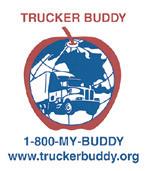1189694 Ontario Ltd. C.O.B. as Over The Road
Publisher Peter Charboneau peter@otrgroup.ca
Director of Operations & Editor-in-Chief Cathryn Charboneau cathryn@otrgroup.ca
Account Executive Luke Zentil luke@otrgroup.ca
Account Executive Earle Madden earle@otrgroup.ca
Graphic Design & Advertising lennykuiper.com lennykuiper@gmail.com
Controller Estela Navarrete estela@otrgroup.ca
Office Manager Mary Charboneau mary@otrgroup.ca
All advertisements, and/or editorials are accepted and published by Over the Road on the representation that the advertiser, its advertising company, and/or the supplier of the editorials are authorized to publish the entire contents and subject matter thereof. The advertiser, its advertising company, and/or the supplier of the editorials will defend, indemnify and hold Over the Road harmless from and against any loss, expense or other liability resulting from any claims or suits for libel, violation of privacy, plagiarism, copyright or trademark infringement and any other claims or suits that may rise out of publication of such advertisement and/ or editorials. Press releases are expressly covered within the definition of editorials.
Great
Minimum
Robert D. Scheper
We truck in North America… not Europe
Consistency and predictability are a necessity for profitability in a competitive environment. The key phrase in that sentence is competitive environment. The trucking industry is deregulated, so the entire industry is competitive. Gone are the days of legislating competitors out of our business (though many still try). I have a friend who works in an industry with very few competitors. His work is more sporadic but when he makes money it’s large and has significant margin. Sometimes when he works, he may well be called in the middle of the night and then for days at a time… but then not again for several months. He keeps his customers because he is in his truck less than 30 minutes after his call. His “competitors” try and fit too many things into their schedule to serve the high-maintenance/highmargin clients. His job is anything but consistent… anything BUT predictable. Trucking, however, cannot survive with inconsistency or an unpredictable environment. The margins are just far too thin for that.
When the US EPA announced sweeping changes to their standards, many people and entire industries breathed a sigh
of relief. The monumental standards imposed within the last 20+ years have created a death spiral for many in the trucking industry.
I was around when the late 1990s pushed through one of the first few stages of EPA standards. Though I admittedly did not know much about what was coming, I became very concerned when media began pumping article after article “promising” that fuel consumption will NOT be affected. They announced the additional costs would add only $10,000 per truck. For reference, trucks around 1999/2000 cost $125-135,000 for a dream machine. At that time the most I ever paid was $95,000. Everyone knows how the EPA standards affected fuel consumption, how it affected performance, shutdowns and maintenance issues over the last two decades. Though the fuel economy has admittedly been impressive over the last few years… the cost of asset purchase is nearly insurmountable.
I have a very significant sample size of clients in the operator segment. I am regularly asked if it makes sense to purchase a new truck with good fuel

consumption or an old truck with a low purchase price. My answer is always the same… it depends on the predictability of your volume of work and rates. If you are on a scheduled run and nothing will change in the next 5-6 years, you should be fairly safe to buy a new truck. But if you can’t guarantee your miles or rate/ volume, the risk is probably too high for a $200+k purchase. I have a client who got a new truck 26 months ago and was ok till about January of this year. His miles went from 12-13,000+ down to 10,50011,000 or less. With his fixed $4500 truck payment, his take-home dropped down to below zero. He started racking up personal debt, month over month. He has been my client for over 10 years, and he has always worked an average of 275-285 days per year, which is considerably more than the national average of 240-250 days. However, even with working that many days a year… he now runs a deficit. He traded in a paid for truck for a brand new one at a very wrong time in history. He overpaid just before a downturn. It will take him 4-5 years to recover (if all goes well). Obviously, our volumes and rates are critical to our survival.
If Canada wishes to continue working with the very lucrative US freight market, they will need to be instantly compatible to the new US EPA standards. One month’s delay would be inconsistent with survival. The last thing we want is something like
a Mexico/USA border standard where travel is restricted. Shutting out the US trucks because of “non-compliance” will guarantee a separation/divorce with our high-margin neighbors. The last thing we need to show the US market is more elbows. I hope the elected officials in our country understand our dependence on uniformity. Like it or not, we flow where the US flows. We can’t have European EPA Standards… we don’t truck there.
About the Author:
Robert D. Scheper is a leading Accountant and Consultant exclusively serving the Lease/ Owner Operator industry in Canada. His first book in the Making Your Miles Count series “taxes, taxes, taxes” was released in 2007. His second book “Choosing a Trucking company” is the most in-depth analysis of the independent operator industry today. He has a Master degree (MBA) in financial management and has been serving the industry since he and his wife came off the road in 1993. His dedication, commitment and strong opinions can be read and heard in many articles and seminars. You can find him at www.makingyourmilescount. com or 1-877-987-9787.
CHECK OUT THE PODCASTS AT “YOUTUBE.COM/@MAKING YOUR MILES COUNT”
Our new Geotab Go Focus Camera
Your fleet’s extra set of eyes on the road.
Intelligent safety alerts, event-driven recording and real-time insights help prevent collisions, protect drivers and cut fleet costs without invading privacy by recording only road-facing footage during specific key driving events.
Give GPS to Go Powered by Geotab a try, you won’t be disappointed.
We have been around for nearly 20 years; we are Canadian owned/ operated and we understand what customer service means!
Chris Harris
What Keeps Truckers Up at Night?
Recently, I did what any curious person does when they can’t sleep – I googled ‘what are truck drivers concerned about?’ The results were enlightening, revealing two major concerns that are weighing heavily on drivers’ minds. They are:
The state of the economy and the shortage of safe truck parking.
additional downward pressure on freight rates that were already struggling. The result? Many trucking companies find themselves in the untenable position of moving freight at a loss –a business model that simply cannot continue indefinitely.
The Squeeze: Rising Costs Meet Falling Rates
Before you think these are just typical industry complaints, let me explain why these two issues are deeply interconnected and have a real impact on drivers and companies across the country.
First, Economic Reality: Four Years of Struggle
The trucking economy has been fighting for survival now for approximately four years, and that’s putting it mildly. Long before recent political changes took center stage, freight rates were already problematically low – far below where they need to be for a healthy, sustainable industry.
The post-election period has introduced significant uncertainties into the marketplace. Regardless of your political views – and that’s not what this article is about – the reality is that policy changes and political turbulence have created an environment where many companies are hesitant to make major spending commitments. They’re adopting a ‘wait and see’ approach, hoping to understand how new policies will affect their operations before investing in growth or expansion.
This corporate caution has created a ripple effect throughout the trucking industry, putting
Here’s where the situation becomes particularly challenging. While freight rates remain depressed, virtually every other cost associated with trucking operations continues to rise. It’s a perfect storm of economic pressures that’s putting tremendous strain on the industry.
Drivers desperately need wage increases to keep pace with inflation. The cost of necessities – food, housing, fuel for personal vehicles – has risen substantially, yet many companies simply cannot afford to provide the raises their drivers deserve and need.
Meanwhile, the capital costs of running a trucking operation continue to escalate. New trucks and trailers are significantly more expensive than they were just a few years ago. Fuel costs remain volatile and subject to inflationary pressures. Insurance rates have been particularly brutal, with many companies seeing increases that far exceed general costof-living adjustments.
These mounting pressures are making it increasingly difficult for smaller trucking companies to remain profitable. If you are currently employed by a trucking company that’s managing to turn a profit in this environment, you are likely working for one
of the fortunate few that have secured solid contracts with shippers and aren’t dependent on the volatile spot market.
The spot market, where load brokers facilitate freight movement, has become particularly challenging for trucking companies. With rates so soft, brokers can move freight at rock-bottom prices, creating intense competitive pressures that many smaller operators simply cannot match while maintaining profitability.
Second: The Parking Crisis. Safety Takes a Back Seat to Budget Constraints
The truck parking shortage represents a serious safety and quality-of-life issue for drivers, but it’s also a problem that seems unlikely to see resolution anytime soon. The economics are straightforward but discouraging. Tax revenues are down while government spending obligations remain constant.
This fiscal reality forces governments at all levels to prioritize their expenditures carefully. Unfortunately, truck parking infrastructure rarely makes it to the top of the priority list. The safety and well-being of drivers during their federally mandated 10-hour rest periods simply doesn’t generate the political pressure necessary to drive significant public investment.
The irony is stark – we depend on truck drivers to keep our economy moving, yet we’ve failed to provide them with basic infrastructure needs like safe, adequate parking. Drivers are forced to park in unsafe locations, deal with overcrowded facilities or drive beyond their optimal stopping points to find available spaces.
The Broader Impact: These issues aren’t just abstract economic problems – they have real consequences for real people. Driver retention becomes increasingly difficult when companies can’t offer competitive wages. Safety concerns multiply when drivers are forced to park in suboptimal locations. The stress of operating
in an economically challenging environment affects not just business owners but every driver trying to make a living in this industry.
Small trucking companies, which form the backbone of the industry, are being squeezed particularly hard. Many are operating on razorthin margins, or, in some cases, they are losing money on loads just to keep their operations running and their drivers employed.
Looking Forward: The truck parking crisis will likely persist until there is either significant government investment in infrastructure or until innovative private-sector solutions emerge. Given current fiscal constraints, the timeline for meaningful improvement remains uncertain.
As for the economic challenges, much depends on broader economic recovery and stabilization. Until freight rates recover to sustainable levels and the various cost pressures ease, the industry will continue to face significant headwinds.
The trucking industry has weathered difficult periods before, and it will likely navigate through this challenging time as well. However, the current combination of economic pressures and infrastructure shortfalls represents a particularly difficult set of circumstances that will require both resilience and creative problem-solving to overcome.
For now, drivers and companies alike are doing what they do best – adapting, persevering, and keeping America’s freight moving, even when the road ahead looks uncertain.
Stay safe.
Chris Harris CEO & Top Dawg Safety Dawg Inc.
Chris@safetydawg.com www.safetydawg.com 905 973 7056
556 Upper Wentworth St. Hamilton, ON L9A 4V2
SEARCHING FOR A















































